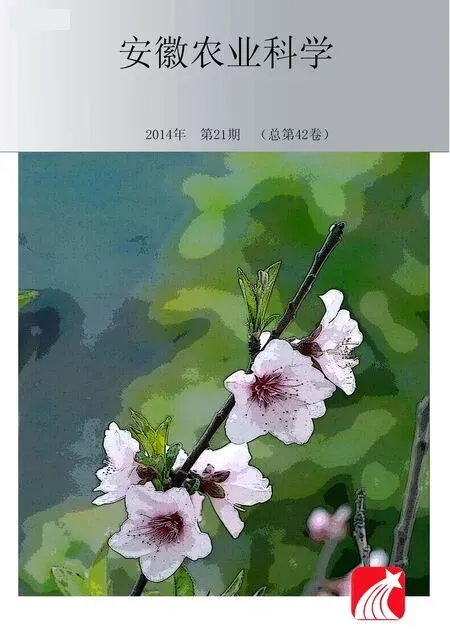不同抗虫棉品种简化整枝方式研究
摘要[目的]对鲁西种植的3个抗虫棉品种的不同整枝方式进行研究,为该区域棉花简化栽培提供依据。[方法]供试抗虫棉品种分别为鲁棉研28、K638和K836,以鲁棉研28为对照。设不整枝(除打顶外不整枝,叶枝顶和赘芽也要保留)、精细整枝(按常规精细管理,去叶枝、抹赘芽、打边心、去无效蕾等,去叶枝时保留主茎叶)、粗整枝(6月10日前后将果枝以下的枝叶全部捋去,即撸裤腿,以后除打顶外不再整枝)3个处理。[结果]鲁棉研28和K638粗整枝既能够保证较高子棉产量、皮棉产量,较好的纤维品质,又能够有效减少棉田用工,在用工价格越来越高的实际情况下,棉农的纯收益最高;K836子棉产量、皮棉产量、纤维品质在精整枝、粗整枝、不整枝的整枝方式下差别较小,但不整枝较粗整枝的整枝方式田间治虫效果差,会增加一定棉田用工,建议也以粗整枝方式为主。[结论]在鲁西区域土壤肥力中等的种植条件下,鲁棉研28、K638进行粗整枝,K836进行粗整枝或不整枝,能够有效减少棉田用工,获得最高纯收益。
关键词抗虫棉品种;整枝方式;纯收益
中图分类号S562文献标识码A文章编号0517-6611(2014)21-06951-02
Study on the Simplified Pruning Ways of Different Cotton Varieties
LI Dongyun(Liaocheng City Promotion Center foe New Crop Variety, Liaocheng, Shandong 252000)
Abstract[Objective] The aim was to study different pruning ways of 3 pestresistant cottons planted in western Shandong, and provide a basis for cotton simplified cultivation of this area. [Method] The trial pestresistant cottons were Lumianyan 28, K638 and K 836, resp. and Lumianyan 28 was taken as CK. There pruning ways were designed, which were no pruning(namely no pruning except for topping, and remaining leaf and branch top and burdensome buds), careful pruning(namely according to the normal precision management, removing leaf and branch, burdensome buds, invalid flower buds, but remaining the leaf of main stem), rough pruning(namely removing all branches and leaves below fruit setting branch at about June 10, after that no pruning except for topping), resp.. [Result] The rough pruning of Lumianyan 28 and K638 not only guaranteed high seed cotton yield and lint yield and good fiber quality, but also reduced the labor in field effectively, so the farmer pure income was the highest under the actual situation of labor price higher and higher; The seed cotton yield, lint yield and fiber quality of K836 had less difference among 3 pruning treatments, but the peat control effect of no pruning in field was worse than than of rough pruning, increased the labor in a certain, so it was suggested to priority to rough pruning way. [Conclusion] Under the middle level soil fertilizer of western Shandong, that Lumianyan 28 and K638 roughly pruning and K836 roughly pruning or no pruning reduce the labor in cotton field effectively, and obtain the highest pure income.
Key wordsPestresistant cotton; Pruning way; Prue income
基金項目山东省财政厅项目。
作者简介李冬云(1970- ),女,山东聊城人,农艺师,从事作物新品种栽培与推广研究。
收稿日期20140623我国是世界上最大的棉花消费国和进口国,其产业的兴衰对国民经济有着重要影响。目前,黄淮地区乃至全国棉花正面临种植面积逐年减少的严重威胁,其主要原因就是费时费力,效益不高。而简化整枝能够有效减少棉田用工[1-3],简化整枝方式虽多有报道,但不同地域不同品种之间不尽相同[4-6]。为此,笔者对目前鲁西棉区推广的3个转基因抗虫棉品种的简化整枝方式进行研究,旨在为该区域棉花简化栽培提供依据。
1材料与方法
2结果与分析
2.1不同整枝方式对抗虫棉单株铃数的影响由表1可知,7月15日,3个抗虫棉品种不同处理铃数在四桃中所占比例由精整枝到粗整枝到不整枝依次递减,不整枝处理的铃数在四桃中所占比例明显低于精整枝及粗整枝。K638、K836各处理铃数在四桃中所占比例大于对照鲁棉研28。8月15日,3个品种不同处理的铃数在四桃中所占比例基本遵循精整枝到粗整枝到不整枝依次递加的趋势,K638、K836精整枝及粗整枝处理在四桃中所占比例小于对照鲁棉研28,不整枝处理在四桃中所占比例大于对照鲁棉研28。8月30日,3个品种不同处理的铃数均以不整枝处理的在四桃中所占比例小。9月15日,K638、K836不整枝处理的铃数在四桃中所占比例小于对照鲁棉研28,其余处理3个处理间均差别较小。
2.2不同整枝方式对抗虫棉农艺性状及纤维品质的影響由表2可知,3个品种不同处理单株棉柴干重由精整枝到粗整枝到不整枝依次递减;K638、K836各处理的单株棉柴干重低于对照鲁棉研28。 烂铃率3个品种均表现为不整枝处理明显偏高。断裂比强度3个品种均表现为不整枝处理明显偏高,其他各项指标均变化较小。
2.3不同整枝方式对抗虫棉产量及产量构成因素的影响由表3可知,鲁棉研28不同整枝方式子棉产量与皮棉产量相同,表现为精整枝到粗整枝到不整枝依次递减,精整枝、粗整枝处理子棉产量、皮棉产量均极显著大于不整枝,但精整枝、粗整枝产量差异不显著。K638不同整枝方式产量趋势与鲁棉研28相同,但产量低于鲁棉研28。K836产量则表现为各处理间差异不显著。3个品种各处理的铃重有从精整枝到粗整枝到不整枝依次递减的趋势,鲁棉研28、K638精整枝、粗整枝处理铃重均极显著大于不整枝,精整枝、粗整枝处理铃重差异不显著;K836各处理间铃重差异不显著。3个品种不同处理的衣分差异不显著。
3讨论与结论
鲁西棉区,不同基因型抗虫棉品种鲁棉研28、K638、K836不同整枝方式处理的农艺性状、产量构成因素、产量、品质有一定差异。
鲁棉研28、K638粗整枝既能够保证较高子棉、皮棉产量,较好的纤维品质,又能够有效减少棉田用工,在用工价格越来越高的实际情况下,棉农的纯收益较高。而K836则与鲁棉研28、K638不同,其子棉产量、皮棉产量及纤维品质在精整枝、粗整枝、不整枝方式下差别较小,但不整枝较粗整枝田间治虫效果差,会增加一定棉田用工,建议也以粗整枝为主。
参考文献
[1] 侯俊奎,杨君立,翟金中.棉花简化整枝栽培技术[J].中国棉花,2005(11):31.
[2] 杨艳敏,欧阳竹,王淑芬.棉花在不同整枝方式下生长发育规律的研究[J].华北农学报,2012,27(S1):234-239.
[3] 李维江,董合忠,李振怀,等.棉花简化栽培技术在山东的效应研究[J].中国棉花,2000,27(9):14-15.
[4] 曹宗鹏,朱书伟,徐青,等.河南南阳棉花简化栽培模式研究与实践[J].中国棉花,2010(7):33-35.
[5] 王菊英,钱锋. 长江中下游高产简化栽培技术与棉花增产途径探讨[J].安徽农业科学,2005(4):576-577.
[6] 毛树春,李万九.棉花叶枝利用机理及其配套高产简化栽培技术[J].农村实用技术与信息,2002(5):21-22.
[7] 王顺领,王永华.棉花高产高效简化栽培技术[J].安徽农学通报,2005(S1):58-60.

